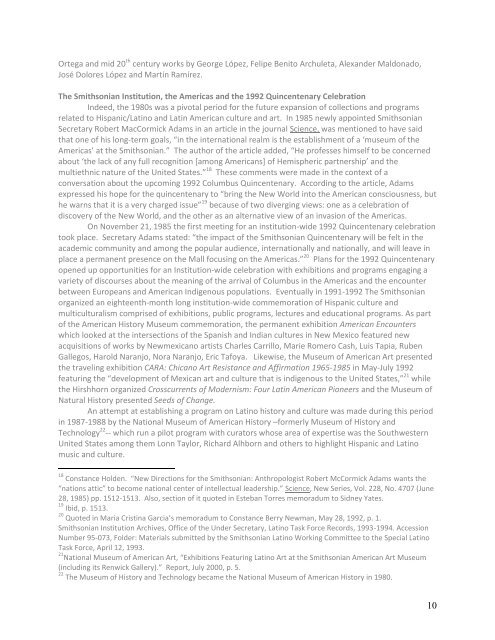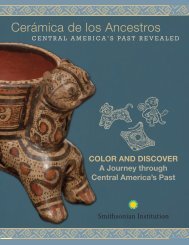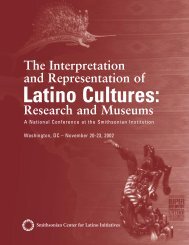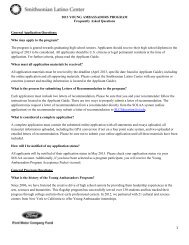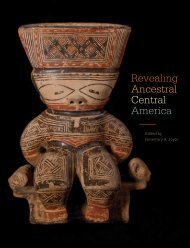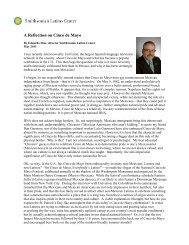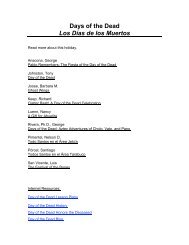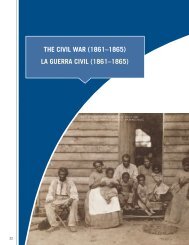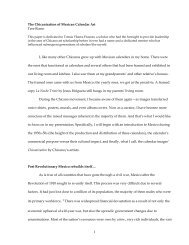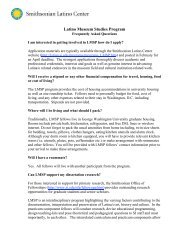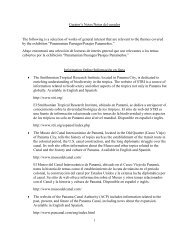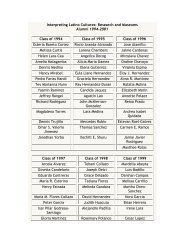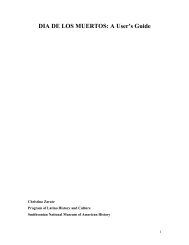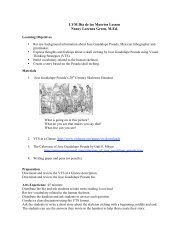smithsonian latino art collections - Smithsonian Latino Center
smithsonian latino art collections - Smithsonian Latino Center
smithsonian latino art collections - Smithsonian Latino Center
You also want an ePaper? Increase the reach of your titles
YUMPU automatically turns print PDFs into web optimized ePapers that Google loves.
Ortega and mid 20 th century works by George López, Felipe Benito Archuleta, Alexander Maldonado,<br />
José Dolores López and M<strong>art</strong>ín Ramírez.<br />
The <strong>Smithsonian</strong> Institution, the Americas and the 1992 Quincentenary Celebration<br />
Indeed, the 1980s was a pivotal period for the future expansion of <strong>collections</strong> and programs<br />
related to Hispanic/<strong>Latino</strong> and Latin American culture and <strong>art</strong>. In 1985 newly appointed <strong>Smithsonian</strong><br />
Secretary Robert MacCormick Adams in an <strong>art</strong>icle in the journal Science, was mentioned to have said<br />
that one of his long-term goals, “in the international realm is the establishment of a ‘museum of the<br />
Americas’ at the <strong>Smithsonian</strong>.” The author of the <strong>art</strong>icle added, “He professes himself to be concerned<br />
about ‘the lack of any full recognition [among Americans] of Hemispheric p<strong>art</strong>nership’ and the<br />
multiethnic nature of the United States.” 18 These comments were made in the context of a<br />
conversation about the upcoming 1992 Columbus Quincentenary. According to the <strong>art</strong>icle, Adams<br />
expressed his hope for the quincentenary to “bring the New World into the American consciousness, but<br />
he warns that it is a very charged issue” 19 because of two diverging views: one as a celebration of<br />
discovery of the New World, and the other as an alternative view of an invasion of the Americas.<br />
On November 21, 1985 the first meeting for an institution-wide 1992 Quincentenary celebration<br />
took place. Secretary Adams stated: “the impact of the <strong>Smithsonian</strong> Quincentenary will be felt in the<br />
academic community and among the popular audience, internationally and nationally, and will leave in<br />
place a permanent presence on the Mall focusing on the Americas.” 20 Plans for the 1992 Quincentenary<br />
opened up opportunities for an Institution-wide celebration with exhibitions and programs engaging a<br />
variety of discourses about the meaning of the arrival of Columbus in the Americas and the encounter<br />
between Europeans and American Indigenous populations. Eventually in 1991-1992 The <strong>Smithsonian</strong><br />
organized an eighteenth-month long institution-wide commemoration of Hispanic culture and<br />
multiculturalism comprised of exhibitions, public programs, lectures and educational programs. As p<strong>art</strong><br />
of the American History Museum commemoration, the permanent exhibition American Encounters<br />
which looked at the intersections of the Spanish and Indian cultures in New Mexico featured new<br />
acquisitions of works by Newmexicano <strong>art</strong>ists Charles Carrillo, Marie Romero Cash, Luis Tapia, Ruben<br />
Gallegos, Harold Naranjo, Nora Naranjo, Eric Tafoya. Likewise, the Museum of American Art presented<br />
the traveling exhibition CARA: Chicano Art Resistance and Affirmation 1965-1985 in May-July 1992<br />
featuring the “development of Mexican <strong>art</strong> and culture that is indigenous to the United States,” 21 while<br />
the Hirshhorn organized Crosscurrents of Modernism: Four Latin American Pioneers and the Museum of<br />
Natural History presented Seeds of Change.<br />
An attempt at establishing a program on <strong>Latino</strong> history and culture was made during this period<br />
in 1987-1988 by the National Museum of American History –formerly Museum of History and<br />
Technology 22 -- which run a pilot program with curators whose area of expertise was the Southwestern<br />
United States among them Lonn Taylor, Richard Alhborn and others to highlight Hispanic and <strong>Latino</strong><br />
music and culture.<br />
18 Constance Holden. “New Directions for the <strong>Smithsonian</strong>: Anthropologist Robert McCormick Adams wants the<br />
“nations attic” to become national center of intellectual leadership.” Science, New Series, Vol. 228, No. 4707 (June<br />
28, 1985) pp. 1512-1513. Also, section of it quoted in Esteban Torres memoradum to Sidney Yates.<br />
19 Ibid, p. 1513.<br />
20 Quoted in Maria Cristina Garcia’s memoradum to Constance Berry Newman, May 28, 1992, p. 1.<br />
<strong>Smithsonian</strong> Institution Archives, Office of the Under Secretary, <strong>Latino</strong> Task Force Records, 1993-1994. Accession<br />
Number 95-073, Folder: Materials submitted by the <strong>Smithsonian</strong> <strong>Latino</strong> Working Committee to the Special <strong>Latino</strong><br />
Task Force, April 12, 1993.<br />
21 National Museum of American Art, “Exhibitions Featuring <strong>Latino</strong> Art at the <strong>Smithsonian</strong> American Art Museum<br />
(including its Renwick Gallery).” Report, July 2000, p. 5.<br />
22 The Museum of History and Technology became the National Museum of American History in 1980.<br />
10


